Service Page SEO: The Right Way to Optimize Service Pages
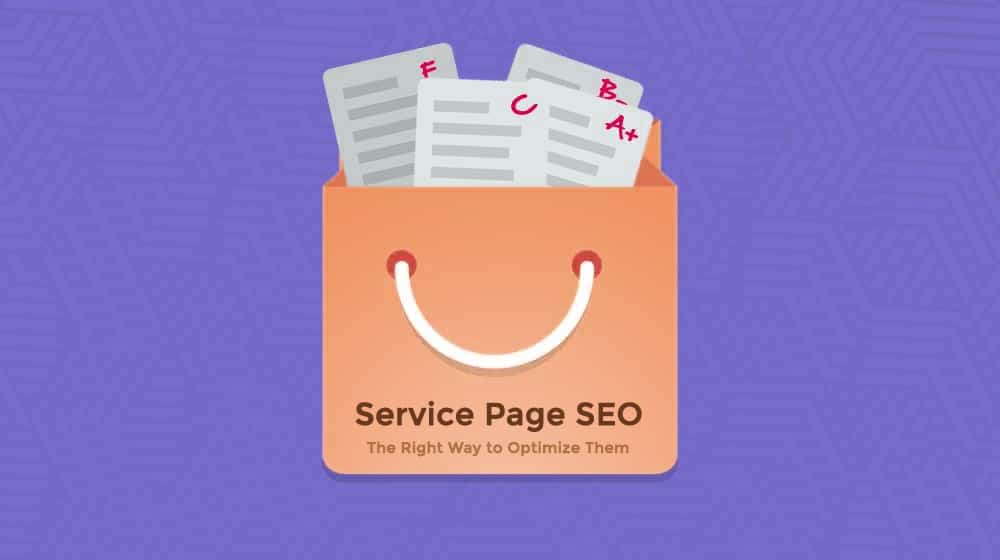
Service pages are some of the most important pages on your site. While other pages bring in more traffic – like good pillar blog posts and linkbait articles – and while landing pages have the potential to convert at higher rates based on ads, service pages are meant to do it all.
Think about it. What's the purpose of a service page?
- It contains information about your services (duh) that can attract users from search results (top of funnel.)
- It contains your value proposition and unique selling point to convince people to give you purchase consideration (middle of funnel.)
- It has sales language and a focused call to action to get users to pull the trigger (bottom of the funnel.)
A good service page is both narrowly targeted to focus on the people most likely to convert and also contains enough broad, general service information to attract users in the first place. It might not be the most focused at any given thing, but it does it all, so you need it to do it all well.
Let's talk about how to make your service pages more valuable, thereby improving your SEO in the process. After all, that's what SEO is all about, right? Correct.
Strong Page Hierarchy
Unless your business has one service that is universal to everyone, chances are you should have multiple service pages, and they should be organized in a strong hierarchy. Google mentions this directly in their webmaster guidelines.
Generally, you want your hierarchy to reflect some aspect of how your service is divided. Most typically, this is either by geographic area, subspecialty, or industry. Here are some examples:
Geographic: Jersey Mike's. Jersey Mike's is a sandwich shop with over 2,000 locations across the country. Since franchise restaurants rely on an individual finding their nearest location, and the menus are going to be consistent across franchises, the primary division of sub-pages for services is location.
While their actual website takes your IP address and presents you with your nearest locations, you can see an example of an overall page here: https://www.jerseymikes.com/locations/all. You can drill down into a state and see all locations in that state quickly and easily.
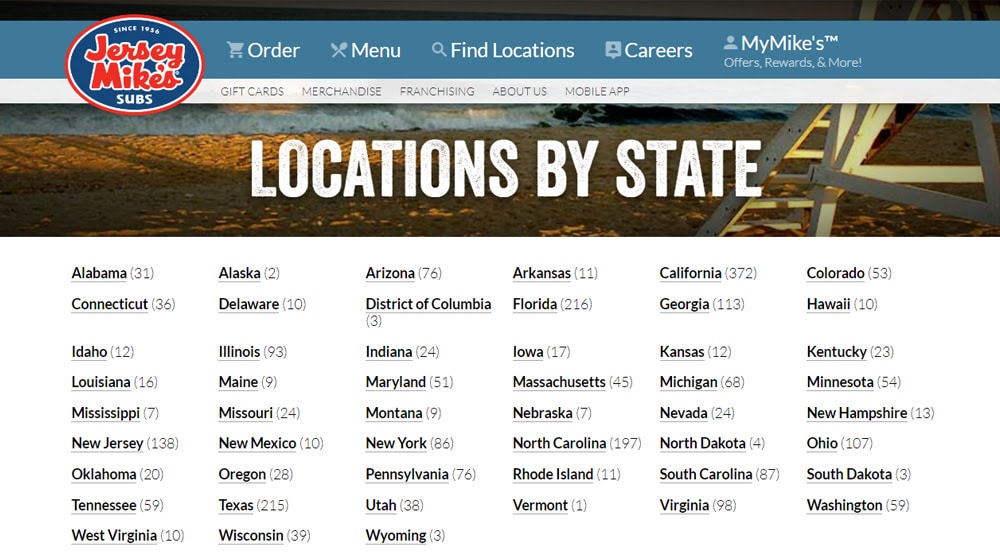
Subspecialty: Orkin Pest Control. Orkin is a national company offering pest control services. Their primary service page is https://www.orkin.com/pest-control, which is a top-level service page. It's not super robust, but it has a large number of links to more specific service pages. Each individual type of pest has its own sub-page, which includes specific, relevant information about the pests and how to deal with them, and a call to action to call Orkin to do it for you.
Industry: Square. As a payment processor, Square offers basically the same product across a wide range of different industries, with customizations tailored to those industries. By browsing their website, https://squareup.com/us/en, you can look at their services divided by business type and view specific offerings for things like beauty spas, restaurants, retail outlets, and home repair companies.
All of these are, essentially, the same in structure. You have the homepage, with a sub-page for the overall product or service organization type, with sub-pages for each type there, which may be service pages or maybe another tier of hierarchy for further subdivisions. The larger the company and the wider the offerings, the more divisions there will be.
One nationwide service page can't include the thousands of local geographic keywords you'd need to reach local users, but subdivided pages can.
One key here is that each bottom-level page, despite being largely similar, needs to be different enough that it won't trigger duplicate content or thin content penalties. No copying and pasting the same exact page with a single keyword changed, at least not without canonizing one of them and hiding the rest.
Relevant and Useful Content
It should come as no surprise that the core of any good page when it comes to SEO, is good content. Strong, top-level keywords are a must. Long-tail keywords follow and should be tailored specifically to the page's position in the hierarchy, with as little overlap with other pages as possible.
Orkin is again a great example here. While each individual pest page takes the same form and design, and a good portion of the content (including calls to action) is the same on each page, there's a bunch of unique and useful content about each specific pest on each page.
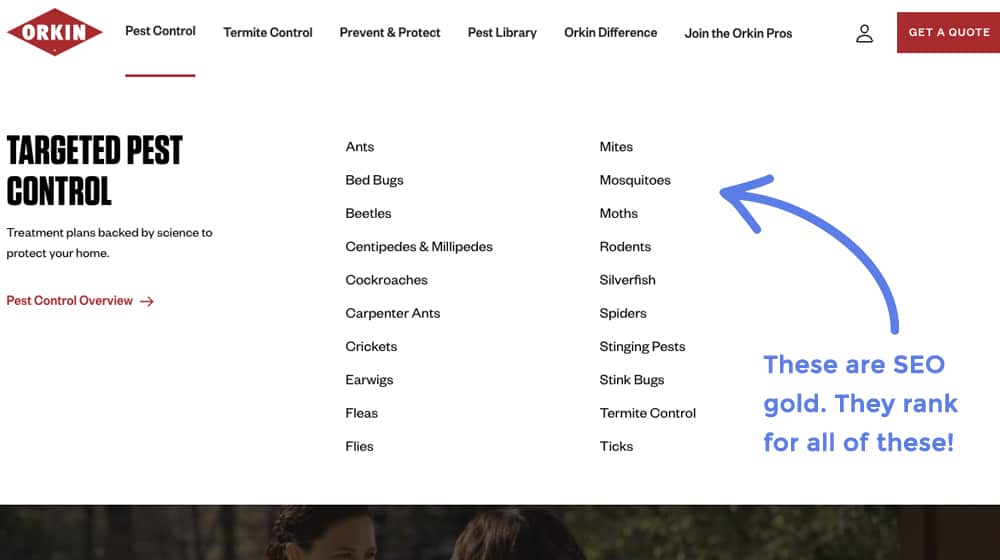
While dividing up service pages to hit a broader selection of audience might seem like a good idea, if you can't come up with enough ways to make each page distinct and unique, it might not be a good idea to divide them. Instead, find ways to add on-page navigation, like tabs that swap between residential or commercial versions of a service or other more dynamic adjustments that can all be indexed together.
My rule of thumb is to look at what your closest competitors are doing and aim for something about 3x better. Word count, while it's not everything and there is no magic word count, is still a factor here.
A surprising number of businesses keep their service pages light on text, and longer gives you more room to add more useful keywords and content. This is a unique opportunity for your page to be more comprehensive and better than your competitor's page. As long as you can find relevant things to say, don't be afraid to say it - you can always add and remove content later to test!
If you want to add content to your service pages but can't think of good keywords to add, I recommend using a tool like Clearscope or MarketMuse. I've had great luck with my clients using Clearscope; it can find some excellent keywords you might otherwise miss.
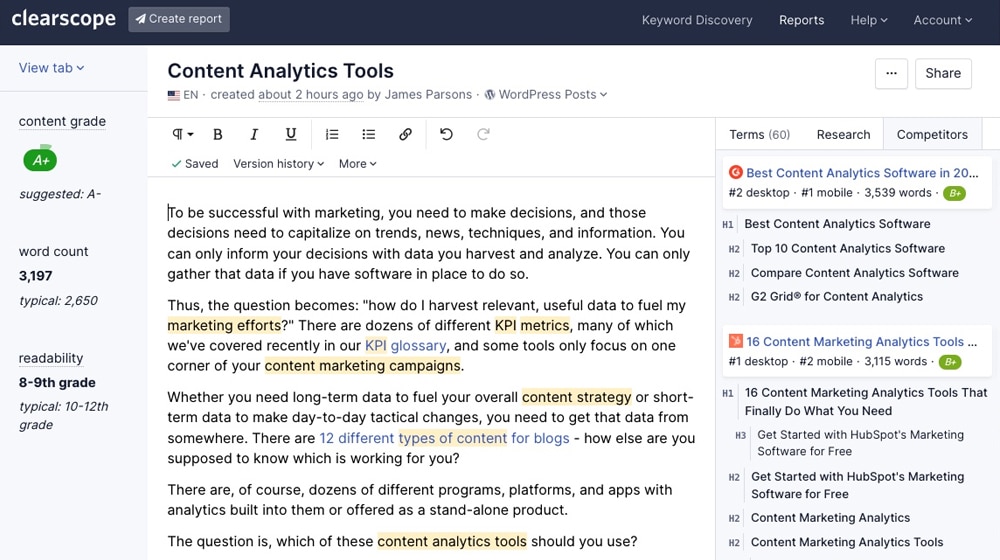
You may also benefit from adding media, particularly video, to your services page. A good video can be very attractive, with the caveat that it only works for certain groups of people. Others will never watch a video on your services page. So, make sure that 100% of the information in a video is on the page itself. This is also important for SEO since Google is unlikely to really index your videos, even if they can.
Another way to add content – without cluttering up your page with dense information – is to make a shuttered FAQ. Orkin is, again, a great example of this. Go to their service pages and scroll down, and you will find an FAQ with common questions about the specific service. The answers are hidden behind drop-downs that Google still reads but don't clutter the main page. They're also all opportunities to link out to more detailed guides if you want, though Orkin doesn't.
Internal Links
Your service pages should have links both to and from them, from a variety of locations throughout your site.
Header and footer links to service pages, including links in your navigation, are essential, of course. However, these links tend to be devalued in terms of SEO because they're "universal" and are on every page. Google doesn't want someone to be able to add one link to a footer and suddenly count as 5,000 new links, so they hugely devalue these kinds of structural links.
I recommend frequently linking your service pages throughout other content pages. You can cross-link from other service pages, and higher-hierarchy pages should link to their sub-pages, but you should also include links in blog content whenever you can. It may feel like being too salesy – and yes, sometimes it isn't fully appropriate – but you can use your best discretion.

Links from your service page are more contentious. Some people adopt the school of thought that any link leading away from a service page that isn't to a purchase page is a lost sale. Personally, I disagree. If someone isn't ready to buy yet but wants to learn more, you want to have those links available to them. If they land on a service page but it's the wrong one, you want them to be able to easily find the right one. You don't want them to bounce! Keeping a visitor around is always better than not.
NAP and Contact Info
Depending on the kind of business you have, your NAP may be absolutely critical information. This is especially true if your service pages are divided by location or if your location has a strict service area. NAP and NAP consistency are very important for search visibility for local searches.

If your physical location isn't important to your service, you can save NAP information for your About and Contact pages. Instead, focus on contact methods that lead to sales. For a service page, there must be a way for a user to convert, after all.
Schema
Service pages are prime candidates for Schema markup, and Schema markup can get you a leg up in all kinds of search results, including things like sitelinks, shopping listings, and enhanced search results.
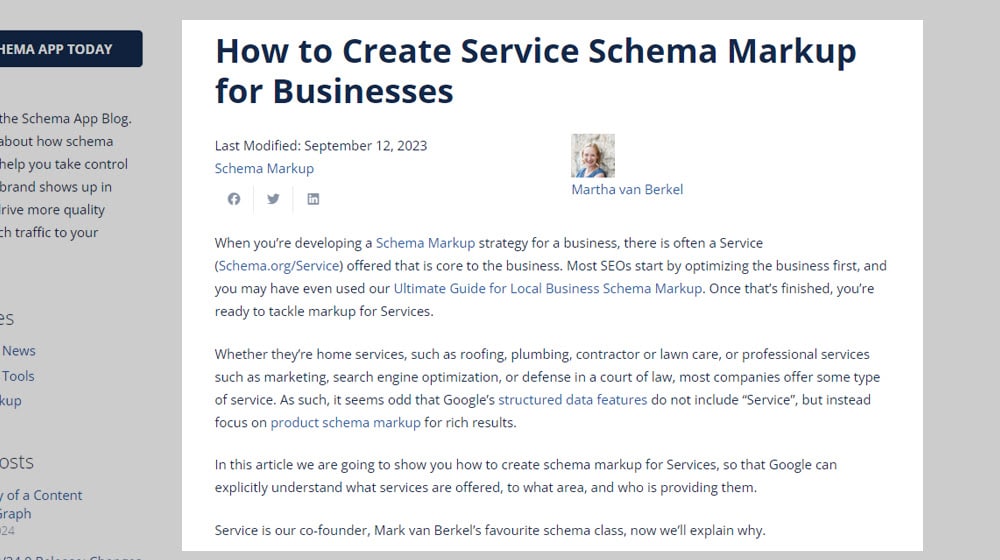
You need to implement it properly; otherwise, it won't work and might even hurt your site. A properly implemented Schema is a surprisingly potent boost to SEO.
Adding social proof to a services page can be a surprisingly effective little bit of content.
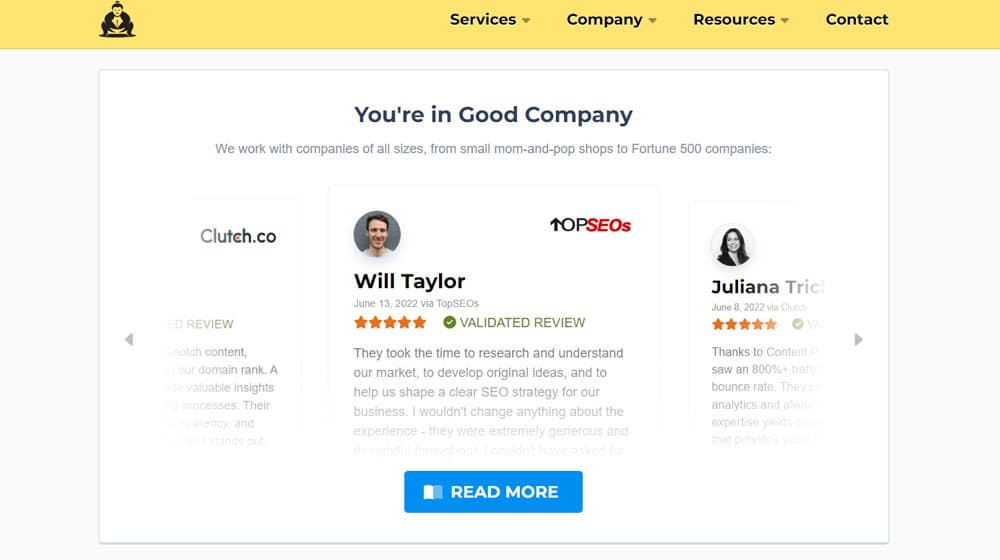
Simple social proof is easy to implement and adds credibility to your business.
- Logos of brands that have worked with you.
- Logos of media outlets that have mentioned you.
- Displays of the number of 5-star reviews you have on sites like Trustpilot.
- Numerical milestones of customer counts.
- Strong testimonials from noteworthy individuals in your industry.
- Quick graphical charts with links to case studies proving the utility of your service.
These kinds of social proof can be implemented easily on a services page (with the exception of case studies, which need more development first) and can all be subtle ways of convincing a user that you're legitimate, trustworthy, and valuable.
Updates
All too often, a business will set up a service page and let it rock for years without a change. It gets stale!
Here's a thought exercise: As a search engine, which would you have more confidence in: a service page updated within the past 12 months, or one last updated 5 years ago? Which is likely still in business?
Now you know why updating your pages often is so important!
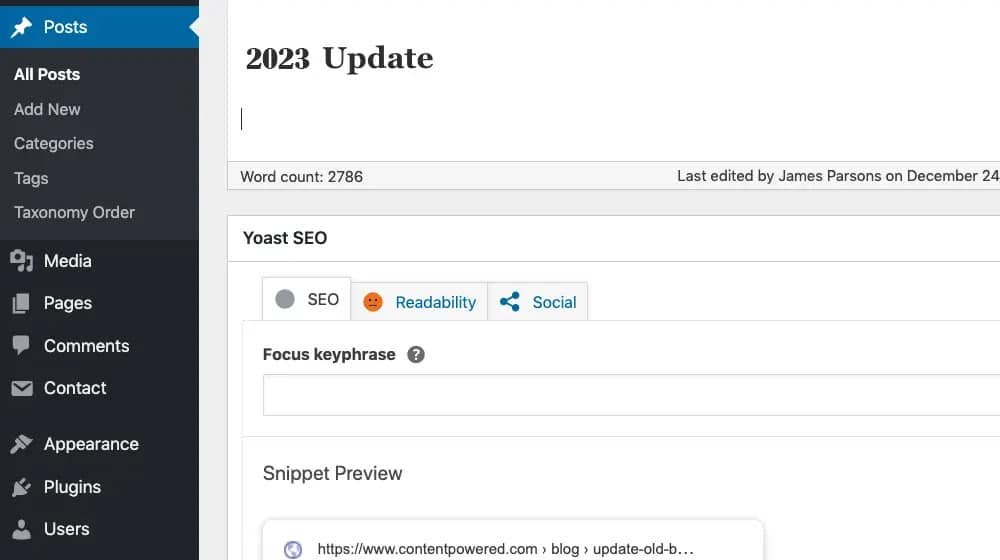
Service pages, like most pages on your site, should be living organisms. They should constantly get small changes, updates to social proof and facts, changes in keywords to target the most relevant of the current set, and even split testing. If you have new services, add them. If your prices change, update that.
Add testimonials, FAQs, and so on. If you can't think of anything to add, try proofreading your content, or upload some of your other marketing material.
I highly recommend doing some kind of change or update to your service pages at least once per quarter.
What Not to Have
While it might seem that you can cram anything and everything into a service page and call it good, there are some elements you want to avoid or remove.

These elements include:
- Carousels, lightboxes, and rotating media. Your page is all about a fast flow of information; if a user has to sit and wait for images to scroll or animations to play, it's a delay that might turn them off entirely.
- Social sharing buttons. No one these days is using social sharing to share product pages or service pages. At most, they'll link to your overall category, but it's a lot more valuable to have these on blog and content posts, not services.
- Cluttered design. You want a quick and easy flow through page elements. You can even assist this with graphical elements like dotted lines and arrows, guiding a reader from point to point.
- Dense paragraphs. No one is going to read more than a few dozen words at a time, so keep your sections short and use plenty of formatting to make key points stand out.
There's no one "Right Way" to make a service page. Browse ten different sites in your niche, and you'll find ten different designs, and all of them work – after all if they didn't, they wouldn't be competitors.
Take ideas from the competition, but focus on making something truly your own!



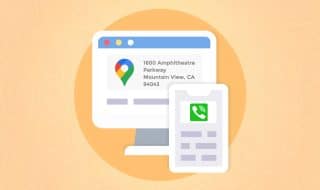



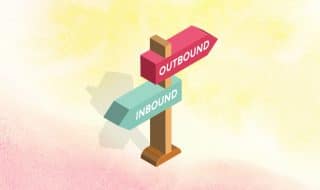


Comments